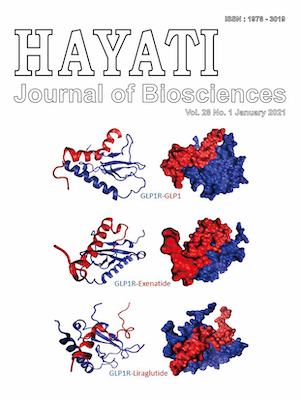In-Silico Design of Novel Glucagon-Like Peptide 1 Mutants as Candidate for New Peptide Agonist Drugs
Abstract
The binding of glucagon-like peptide 1 (GLP-1) incretin hormone and its receptor GLP-1R plays an important role in the human body. The GLP-1 acts as the insulin secretion stimulator through a GLP-1R agonist activation to avoid the type 2 diabetes mellitus problem. A recent development in computational sciences has enabled us to design a new GLP-1 mutant which has a better binding stability to GLP-1R. In this paper, we have conducted an in-depth analysis of protein-protein docking of GLP-1 and GLP-1R receptor to determine the responsible factors affecting the binding stability. The protein-protein binding stability was analyzed by performing the point mutations on the GLP-1 structure and running the molecular dynamics simulation of the docked structures. Five mutants, Lys20Arg, Lys20His, Lys20Ser, Lys20Gly, and Lys20Ala, has been created computationally and docked with GLP-1R and tested via a molecular dynamics simulation and the free energy perturbation calculation to search for the best-binding mutant. Our results have shown that the Lys20His mutant design has the best potential to be developed as a new peptide agonist drug based on its binding affinity and structural integrity as compared to other mutants and the peptide agonist drugs available in the market exenatide, and liraglutide.
Downloads
HAYATI J Biosci is an open access journal and the article's license is CC-BY-NC. This license lets others distribute, remix, tweak, and build upon author's work, as long as they credit the original creation. Authors retain copyright and grant the journal/publisher non exclusive publishing rights with the work simultaneously licensed under a https://creativecommons.org/


















.png) IPB University
IPB University Department of Biology
Department of Biology The Indonesian Biological Society
The Indonesian Biological Society 

